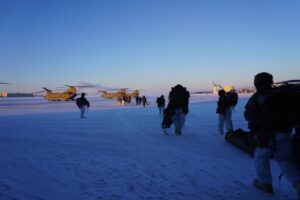The Army on Monday officially reactivated its 11th Airborne Division to be based in Alaska as the service looks to bolster its capability for Arctic operations, which will include shedding its number of Stryker vehicles in this shift toward future cold-weather, mountainous operations.
Gen. James McConville, the Army chief of staff, said the move to reflag U.S. Army Alaska as the 11th Airborne Division will include transforming the current 1st Stryker Brigade Combat Team, 25th Infantry Division into a lighter, more maneuverable 1st Infantry Brigade Combat Team (IBCT), 11th Airborne Division, outfitted with capabilities such as the future Cold Weather All-Terrain Vehicle (CATV).

“We expect them to live up to the legacy of those that have gone before them. We expect them to be masters of their craft in the Arctic warfighting, in extreme cold weather and in mountainous and high-altitude terrain. And we expect them to develop innovative ways of operating in this environment,” McConville told reporters ahead of the reflagging ceremony at Fort Wainwright in Alaska.
Under the move, the 4th Infantry Brigade Combat Team (Airborne), 25th Infantry Division based at Joint Base Elmendorf–Richardson in Anchorage will also become the 2nd Brigade Combat Team, 11th Airborne Division.
McConville said the standing up of the 11th Airborne Division, which establishes an operational headquarters in Alaska, will include the transformation of Stryker elements to an IBCT with a “strong air assault capability” and “the ability to maneuver in the Arctic.”
“The Strykers that we have here are what we would probably call ‘first generation’ Strykers, so they need to be upgraded. Some of them will be used for parts. Some of them will be upgraded. And some of those, when they are upgraded, will be pre-positioned in other places where we may need those systems. So we see a reduction in the cost to maintain the Strykers. We see a reduction in the cost to actually operate those. But at the same time we are going to be investing in equipment and systems that are best-suited for this Arctic environment,” McConville said. “The intent is for the Strykers to start leaving here while the summer months are still here. We want to do that before the winter sets in.”
Maj. Gen. Brian Eifler, commander of the 11th Airborne Division, said the move to an “air assault-capable” IBCT and the divestment of Strykers will allow for a focus on increased mobility and “capabilities for sustained operations in the Arctic cold weather.”
“You’ll probably see a lot less Strykers, maybe a little bit more airborne operations up here because, again, the only Arctic airborne capability is in this unit. And you’re going to see a lot of that,” Eifler told reporters.
The Army is currently pursuing the CATV program to find a replacement for its legacy Small Unit Support Vehicles, in service since the 1980s, with BAE Systems and Oshkosh Defense [OSK] having each submitted bids for the production contract (Defense Daily, March 23).
The companies were the two participants in the CATV prototype evaluation phase, which concluded earlier this year, with the Army set to award the production contract likely this summer.
Last March, the Army released its new Arctic strategy which called for delivering new capabilities to bolster operations in harsher cold-weather, mountainous conditions, to include a need for an improved cold-weather all-terrain vehicle, new power generation systems, unmanned technologies and space-based communications systems to support future Arctic units (Defense Daily, March 16 2021).
Sen. Dan Sullivan (R-Alaska) told reporters he viewed the move to reactivate the 11th Airborne Division in Alaska as a “sea change” after what he saw as the Pentagon’s “non-existent” emphasis on the Arctic in the recent past, to include shutting down bases and units.
“What I think is happening today represents a sea change in the Pentagon’s focus on the Arctic,” Sullivan said. “With the 11th Airborne Division, we now have a strategically-located tough unit that can deploy thousands of airborne troops anywhere in the world.”